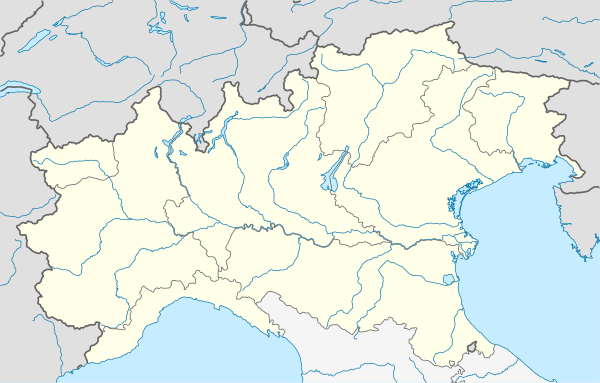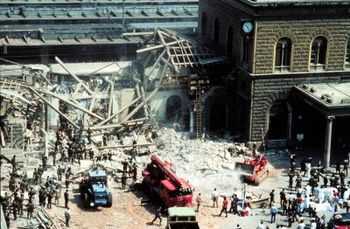Bologna Centrale railway station
Bologna Centrale | |
|---|---|
|
View of the station building in 2006 | |
| Location |
Piazza delle Medaglie d'Oro 40121 Bologna Italy |
| Coordinates | 44°30′21″N 11°20′30″E / 44.50583°N 11.34167°ECoordinates: 44°30′21″N 11°20′30″E / 44.50583°N 11.34167°E |
| Owned by | Rete Ferroviaria Italiana |
| Operated by | Grandi Stazioni |
| Line(s) |
|
| Distance |
96.908 kilometres (60.216 mi) from Firenze Santa Maria Novella |
| Platforms | 27 |
| Construction | |
| Architect | Gaetano Ratti |
| History | |
| Opened | 1864 |
| Location | |
 Bologna Centrale Location within Northern Italy | |
Bologna Centrale is a railway station in Bologna, Italy. It is at the southern end of the Milan-Bologna high-speed line, which opened on 13 December 2008 and the northern end of the Bologna–Florence Direttissima, opened on 22 April 1934. A new high-speed line to Florence opened on 13 December 2009.
The station is the fifth busiest in Italy, with an annual ridership of 58 million.[1]
History
The first Bologna Centrale station was constructed in 1859; however, there are sketchy and unclear testimonies regarding its history. A new station was built twelve years later on the same grounds.
The station as we know it today was designed and built by architect Gaetano Ratti, who had trained in the local Clementine Academy. Inspired by the neoclassical style, its distinctive 15th century façade opens in nine entrance doors. The main passenger building is reminiscent of renaissance Florentine architecture. Until the 1940s it was topped by a clock tower with marble pillars, but the tower was damaged by bombing in World War II and was not rebuilt.
The original design called for a rectangular shaped two-faced building, with a marble external façade and steel internal one. Subsequent extension works, such as the 1926 building of the westbound platforms, shaped the station into the “L” form typical of expanded transit stations. Later, the introduction of new platforms on the eastern half (1934) brought another change to the station's configuration.
Train services
The following services call at the station (incomplete):
Domestic (High-speed)
- High-speed train (Trenitalia Frecciarossa): Turin - Milan - Bologna - Florence - Rome - Naples - Salerno
- High-speed train (Trenitalia Frecciarossa): Venice - Padua - Verona - Bologna - Florence - Rome - Naples
- High-speed train (Trenitalia Frecciarossa): Milan - Bologna - Rimini - Ancona
- High-speed train (Italo): Turin (Porta Susa) - Milan (Porto Garibaldi) - Bologna - Florence - Rome (Tiburtina) - Naples - Salerno
- High-speed train (Italo): Venice - Padua - Bologna - Florence - Rome (Tiburtina) - Naples - Salerno
- High-speed train (Italo): Turin (Porta Susa) - Milan (Porto Garibaldi) - Bologna - Rimini - Ancona
- High-speed train (Trenitalia Frecciargento): Bolzano/Bozen - Trento/Trient - Verona - Bologna - Florence - Rome
- High-speed train (Trenitalia Frecciargento): Brescia - Verona - Bologna - Florence - Rome
- High-speed train (Trenitalia Frecciabianca): Milan - Parma - Bologna - Rimini - Ancona - Pescara - Foggia - Bari - Brindisi - Lecce
- High-speed train (Trenitalia Frecciabianca): Milan - Parma - Bologna - Rimini - Ancona - Pescara - Foggia - Bari - Taranto
- High-speed train (Trenitalia Frecciabianca): Turin - Parma - Bologna - Rimini - Ancona - Pescara - Foggia - Bari - Brindisi - Lecce
- High-speed train (Trenitalia Frecciabianca): Venice - Padua - Verona - Bologna - Rimini - Ancona - Pescara - Foggia - Bari - Brindisi - Lecce
Domestic
- Night train (Trenitalia Intercity Notte): Trieste/Triest - Venice - Padua - Verona - Bologna - Florence - Rome
- Night train (Trenitalia Intercity Notte): Milan - Parma - Bologna - Rimini - Ancona - Pescara - Foggia - Bari - (Taranto) - Brindisi - Lecce
- Night train (Trenitalia Intercity Notte): Turin - Alessandria - Bolgona - Rimini - Ancona - Pescara - Foggia - Bari - Brindisi - Lecce
- Night train (Trenitalia Intercity Notte): Turin - Milan - Bologna - Florence - Rome - Naples - Salerno - Lamezia Terme - Reggio di Calabria
- Intercity train (Trenitalia Intercity): Milan - Parma - Bologna - Florence - Rome - Naples
- Intercity train (Trenitalia Intercity): Trieste - Venice - Padua - Bologna - Florence - Rome
- Intercity train (Trenitalia Intercity): Bologna - Rimini - Ancona - Pescara - Foggia - Bari - Brindisi - Lecce
- Intercity train (Trenitalia Intercity): Bologna - Rimini - Ancona - Pescara - Foggia - Bari - Taranto
- Regional train (Trenitalia Regional): Bologna - Ferrara - Rovigo - Padua - Venice
- Regional train (Trenitalia Regional): Voghera - Piacenza - Parma - Modena - Bologna
- Regional train (Trenitalia Regional Express): Mailan - Parma - Reggio Emilia - Modena - Bologna - Forli - Rimini - Ancona
- Regional train (Trenitalia Regional): (Bologna) - Modena - Suzzara - Mantua
Cross-border
(A for Austria, D for Germany, F for France, GB for Great Britain)
- Intercity train (ÖBB EuroCity): Bologna - Verona - Rovereto/Rofreit - Trento/Trient - Bolzano/Bozen - Bressanone/Brixen - Fortezza/Franzensfeste - Brennero/Brenner - Innsbruck(A) - Jenbach(A) - Kufstein(A) - Munich(D)
- Night train (DB CityNightLine): (Rome) - (Florence) - (Bologna) - Verona - Trento/Trient - Bolzano/Bozen - Innsbruck(A) - Jenbach(A) - Kufstein(A) - Munich(D)
- Night train (ÖBB EuroNight): (Rome) - (Livorno) - Florence - Bologna - Verona - Padua - Venice - Villach(A) - Klagenfurt(A) - Vienna(A)
- Tourist train (Venice-Simplon Orient Express): Rome - Florence - Bologna - Verona - Innsbruck(A) - Paris (East)(F) - London(GB)
Current station

Today, Bologna Central Station is the fifth-busiest in Italy in terms of passenger movements (about 58 million passengers per year). It is, however, one of the busiest when measured by train traffic, being tied with Rome Termini Station for the number of trains per day (about 800) being one of the main railway junctions in Italy.[2]
A new three-level railway station for high-speed trains, 642 metres long and 56 metres wide, is being built under the current station to a design by Arata Isozaki and Andrea Maffei, with parking at 7 metres below the surface, a shopping arcade at 15 m below and four high-speed train platforms at 23 m below. In July 2008 Andrea Maffei Architects, Arata Isozaki & Associates, Ove Arup & Partners and M + T & Partners won a competition to design the station. The underground platforms were opened for revenue service on 9 June 2013. The passenger drop-off facilities will be provided in a later phase. Together with the reinstatement of four surface tracks removed to facilitate construction, the project is due to be completed by 2016.[3] The expected at design phase cost was €340 million.[4]
1980 terrorist bombing

On 2 August 1980 at 10.25 am, an improvised explosive device (IED) made with 20 kilograms of a TNT mixture was detonated inside Bologna's main railway station. The IED was contained in a suitcase, which was placed near the wall inside a waiting lobby. The explosion killed 85 people and injured more than 200. The wing of the station in which the bomb was detonated has been reconstructed but, as a testimony to the victims of the attack, the original pavement was maintained as well as a deep crack in the main wall. Moreover, the station main clock is forever stopped at the exact time of the explosion. The attack is also known in Italy as the Strage di Bologna, the Bologna massacre.
The Italian government immediately accused the Italian leftist militant group Red Brigades for the attack; however this was denied by the group, and no one ever claimed responsibility. Over the years, official investigation has determined that the attack was carried out by a small neo-fascist group. Many conspiracy theories regarding this event have been entertained, including a link between this act of terrorism and the Aerolinee Itavia Flight 870 disaster.
See also
- History of rail transport in Italy
- List of railway stations in Emilia-Romagna
- Rail transport in Italy
- Railway stations in Italy
- 11 March 2004 Madrid attacks
- List of terrorist incidents
- Bologna metropolitan railway service
References
- ↑ "Bologna Centrale". Grandi Stazioni. Retrieved 30 December 2011.
- ↑ GrandiStazioni
- ↑ Railway Gazette
- ↑ "Arata Isozaki wins in Bologna". Today's Railways Europe. September 2008. p. 53.
External links
| Wikimedia Commons has media related to Bologna Centrale railway station. |
| ||||||||||||||
| ||||||||||||||||